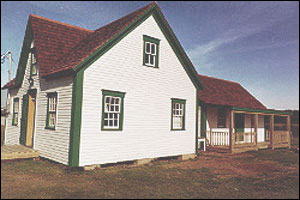Hulan House
(Jeffrey's)
Leonard Hulan Senior designed and built the Hulan House in 1865-1866. He sawed the lumber used in the dwelling with a pit saw and used wooden pegs, along with some cut nails, to hold the house together. The structure is a fine example of the architecture of early settlers on Newfoundland's west coast during the eighteenth and nineteenth centuries. Today, it is the last of its type of structure in the area.

Hulan initially built the structure as a salmon net storage building in the east end of Jeffrey's. He fished in the area while living on the same land settled by his great-grandparents, James and Ann Hulan, at Middle Barachois River. It was there that they established the first commercial farm in Newfoundland in the mid-1700s.
Ann Hulan is famous in the Jeffrey's area. During the War of 1812, American privateers captured her and the crew of the vessel Industry while on their way to market in St. John's. The privateers seized the ship's crew and cargo, and took them back to the United States. Ann charmed her captors and arranged to get back the ship and cargo, and return to Newfoundland safely. Adventurer William Cormack, who trekked across Newfoundland's interior in the 1820s, called Ann the "Queen of St. George's Bay." She earned this title for her industrious efforts in sustaining dairy cattle and for her efforts as an experimental farmer.
Before his marriage to Margaret Shears of Robinsons in 1888, Leonard Hulan converted the interior of the net storage building into a dwelling and built another shed for his salmon nets. The structure has been home to the Hulan family for generations. Leonard and Margaret's son, Albert, lived in the house with his wife Annie (neé Shears) and their family until 1972. After that, the present owner, Dr. Howard "Bud" Hulan, inherited the home. Dr. Hulan was a cabinet minister in government of Premier Clyde Wells.
The home is known for several "firsts." The first postal and telegraph offices were located in the home, as was the first telephone in the area. In 1895 Margaret Hulan served as the first postmistress for the region. She held the position until 1925 when her son Albert took control of postal operations. Albert served as postmaster until his retirement in 1965. In 1915 Albert bought the first radio in the area and for a decade locals would gather, especially on Sunday afternoons, and listen to the news, weather and music. Albert served as justice of the peace and commissioner of the supreme court for the colony. He later donated sufficient land to the provincial Department of Health to build a medical clinic for the region.
In recognition of the historical significance of the Hulan house and its occupants, the dwelling became a Registered Heritage Structure in February 1991. This structure was also awarded the Southcott Award for heritage restoration by the Newfoundland Historic Trust.
Also view the Hulan House Registered Heritage Structure on the Heritage Foundation of Newfoundland and Labrador web site. The Newfoundland and Labrador Heritage Web Site has on its site only a portion of the registered heritage structures in Newfoundland and Labrador. To view a complete list or search for a particular structure visit the Heritage Foundation's Property Search page.




